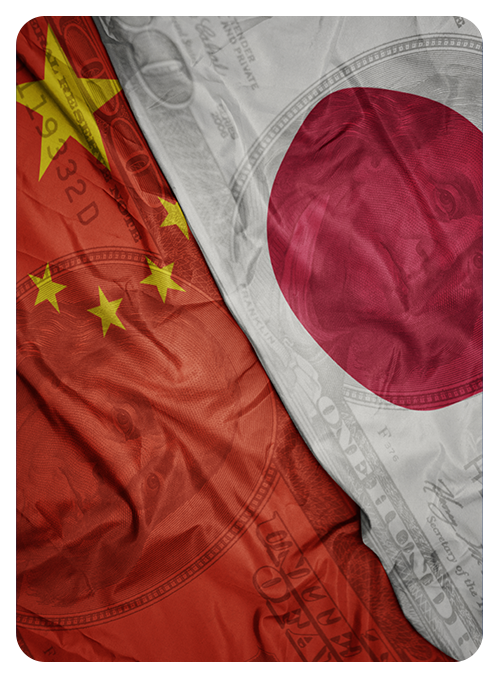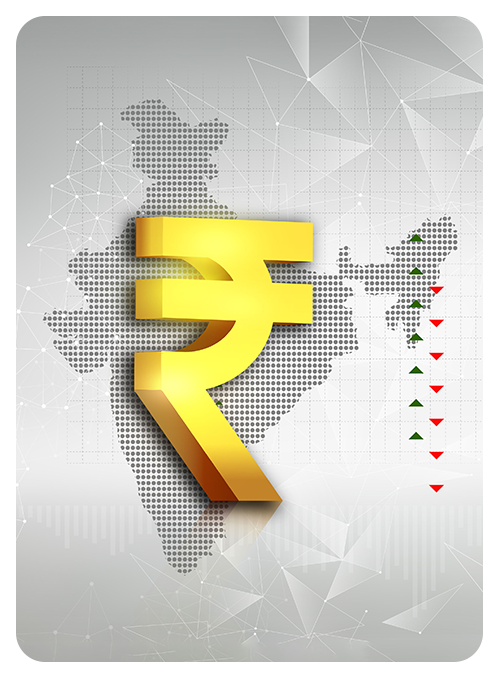Finsphere
Relief Rally for Now:
But Will Trade Talks Derail the Momentum?

Dear Clients and Stakeholders,
Indian equity markets which had nosedived post the Trump’s ‘Liberation Day’ tariff announcement, continued its recovery and extended its recent streak of monthly gains for the fourth consecutive month, notching up 3.1% in June. However, with US tariff issue still unsettled in regard to India and commencement of Q1FY26 results, markets have gone into consolidatory mode. Silver lining being US president stating that a trade deal with India is “very close”.
Now six months into his presidency, Mr. Donald Trump’s economic agenda is taking a more defined shape. The administration’s first big move was to rework trade rules through a wave of tariffs on key partners, reshaping the global trade landscape. The tariffs and trade negotiations which has dominated headlines since April is now hurtling toward a critical moment in July. Some countries, like Vietnam, have acted swiftly — announcing a limited trade deal that reduced US tariffs to 20%, while granting duty-free access to American goods. Others are still in talks while a high-stakes round of negotiations between the US and China took place in London, following weeks of tensions. Encouragingly, China resumed rare earth exports and Boeing restarted aircraft deliveries to China. Meanwhile, Mr. Trump’s administration, in hopes of hastening negotiations, deployed a now familiar tactic by dispatching the first batch of letters to 14 nations including Japan and South Korea, imposing taxes ranging from 25% to 40% on their imports effective from August 1st.
The breakthrough in negotiations with China, a key supplier of rare earths, and the continued trade negotiations with other key partners boosted investor sentiment in US with S&P 500 climbing 4.32% in June, reaching 6,205, while the Nasdaq surged 6.57% to 20,370. The Dow Jones Industrial Average posted a strong 4.32% gain, closing at 44,095, and broader markets reflected similar enthusiasm, with the Russell 2000 advancing 5.3% to 3,245.
As markets digest these developments, focus is likely to stay firmly on trade negotiations and upcoming earnings — all of which will shape the investor sentiments for July.
United States
Inflation Cools as Tariff Impact on GDP Becomes Key Focus.
The US economy, reeling under the impact of tariffs contracted for the first time in three years as GDP growth for Q1CY25 was revised downwards to -0.5% (vs. -0.2% prior estimate). The decline was led by slower consumer spending, tepid exports and a steep 4.6% fall in federal government spending. The spike in imports — up 37.9% YoY — reflected stocking by businesses ahead of anticipated tariff hikes, pushing the trade deficit to $71.5 billion. However, inflationary pressures remained manageable. Headline CPI rose to 2.4% in May, the first uptick in four months. Core PCE, the Fed’s preferred gauge, edged up to 2.7% YoY in May, while Producer inflation was broadly in line with expectations at 2.6% YoY.
Given the uncertain inflation trajectory — particularly with tariffs set to take effect in August — the Federal Reserve held rates steady at 4.25–4.50% for the fourth straight meeting. Fed Chair Jerome Powell signaled caution, noting that the inflationary effects of tariffs were still unfolding. Fed projections now factor in just 50 bps of rate cuts in 2025 and a reduced 25 bps cut for 2026.
Consumption data showed signs of fatigue. Retail sales contracted 0.9% MoM in May — the sharpest decline in four months — led by weakness in autos and building materials. Industrial production fell 0.2% MoM in May, while manufacturing output rose marginally.

However, consumer sentiment rebounded in June — its highest in six months — likely reflecting hopes of softer impact of inflation from tariffs and support from the ‘One, Big Beautiful Bill’ – a bill which introduces tax reliefs and targeted household support.
Meanwhile, the labor market continued to remain resilient, despite showing signs of cooling in labour absorption. Non-farm payrolls rose by 147,000 in June while private payrolls posted their first monthly decline since March 2023 (-33,000). The unemployment rate ticked down to 4.1%, but jobless claims remain elevated, and continuing claims were near three-year highs. JOLTS data showed a surprising rise in openings which stood at 7.77 million, led by hospitality and finance while federal hiring continued to decline.
Housing data remained soft, weighed down by high mortgage rates. Housing starts fell 9.8% MoM in May, and new home sales slumped 13.7% — the steepest drop in three years. Building permits declined to their lowest level since mid-2020. Even as existing home sales and pending home sales posted modest recoveries, the house price index slipped 0.4% in April, pointing to pricing pressure. With tariffs poised to take center stage again post July 9th and questions over sustained growth momentum and the Fed’s ‘wait and watch’ approach, the path forward will be cautiously assessed.

Eurozone & UK
Trade Negotiations and Softening Domestic Demand.
Euro area growth momentum cooled as industrial activity slumped and external demand softened under the weight of renewed tariff risks. Industrial production declined sharply by 2.4% MoM in April — the worst monthly contraction since July 2023. Trade surplus narrowed to €9.9 billion, down from €37.3 billion in March, led by a sharp fall in exports of mineral fuels, machinery, and a cooling chemicals surplus post-US tariffs. Export growth to the US slowed materially (3.9% YoY vs. 63.9% in March), while shipments to China and the UK declined. On the inflation front, headline CPI was 1.9% YoY in May, dipping below the 2% target for the first time since September 2024 meanwhile core inflation also eased to 2.3%, its lowest since January 2022. At the producer level, inflation slowed to 0.3% YoY. However, the unemployment rate rose to 6.3%, up 10 bps MoM.
In the UK, macro signals were similarly mixed. GDP for Q1CY25 grew by 0.7% QoQ, its best performance in a year, led by business investment and export strength. However, retail sales contracted sharply by 2.7% MoM in May, led by food and household goods. Industrial production fell 0.6% MoM, and the trade deficit widened to £7.03 billion — the largest since June 2022 — driven by a slump in goods exports. Meanwhile, inflation edged down to 3.4% in May.
Despite, easing inflation, which edged down to 3.4% in May, the Bank of England kept the policy rate steady at 4.25% as it flagged “two-sided risks” to inflation — balancing persistent core pressures against external tariff-driven volatility. On the labour front, indicators were stable but softening as unemployment ticked up to 4.6%, the highest since mid-2021.
With Euro Area and UK struggling with softening demand environment, the path forward hinges on the region and US reaching a balance trade deal to avoid any economic disruption. While negotiations continue, the sharp escalations from US underscores the fragility of the trade negotiations.
Asia
China’s Industrial Momentum Stutters while Japan’ GDP Contracts.
China’s macro data for May revealed strong domestic consumption but stuttering industrial momentum. Retail sales surprised with a growth of 6.4% YoY — the fastest pace since December 2023 — lifted by holiday spending and government support. In contrast, industrial production growth slowed to 5.8% (vs. 6.1% in April), weighed down by US tariff pressures. The trade surplus widened sharply to $103.2 billion, driven by a deeper-than-expected fall in imports at -3.4% while export growth stood at 4.8%. Consumer inflation remained negative for a fourth straight month at -0.1%, reinforcing concerns over demand-side weakness despite core inflation ticking up to 0.6% and stronger than expected retail sales. The official manufacturing PMI stayed in contraction at 49.7, as factories remained cautious amid a fragile trade truce with the US and an ongoing property sector drag. The PBoC left benchmark rates unchanged, opting to preserve some headroom amid persistent deflationary pressure.
Japan’s Q1 GDP shrank 0.2% YoY, less than expected but marking its first contraction in a year. Industrial production bounced back modestly in May (+0.5%), supported by a rebound in production machinery and autos. Retail sales rose 2.2% YoY in May, the slowest pace since February. Inflation trends were mixed — headline CPI eased to 3.5%, but core CPI rose to 3.7%, its highest level in over two years, reinforcing expectations for further BoJ tightening.

Tokyo core CPI also moderated to 3.1%. Labor market conditions remained strong, with unemployment steady at 2.5% and employment reaching a record high. Manufacturing PMI edged into expansion while the services sector displayed resilience amid rising new orders and steady hiring. However, export momentum remained weak across both manufacturing and services sectors, reflecting ongoing tariff headwinds.
The two of the largest economies in Asia have been left facing different challenges. While China battles a slowdown in industrial output, Japan which has just been slapped with 25% tariffs by US due to stalling trade negotiations could face its own uphill battle. With both countries being largely export driven, particularly in the case of China, resurrecting domestic demand would likely play a critical role in helping weather global shocks.

India’s Economic Pulse:
Resilient Growth Amid Global Turbulence.
India’s macro indicators painted a nuanced picture in May, with sharp disinflation offset by weakening output data and a slight deterioration in labor metrics. CPI inflation dropped to 2.82% — the lowest since February 2019 — on the back of easing food prices, bringing it close to the RBI’s lower threshold. WPI inflation also cooled to 0.39%, led by a 21.6% drop in vegetable prices and moderation in manufacturing cost pressures. Industrial momentum, however, weakened as IIP rose by mere 1.2% YoY in May, as electricity output contracted and mining slipped again. Meanwhile, core infrastructure output growth slowed to 0.7%, the weakest in nine months. On the labour front, jobless rate rose to 5.6% in May, with youth unemployment jumping to 15%, reflecting tepid post-harvest rural demand.
Trade performance was mixed. The April deficit widened to $26.4 billion — the largest since November — before narrowing to $21.9 billion in May. While exports dipped in May by -2.2%, shipments to the US remained strong despite a brief flare-up in tariffs, pointing to underlying competitiveness in key sectors.
Despite the softness in data, forward-looking indicators remained robust. The Manufacturing PMI was at a 14-month high, supported by surging exports and record job creation. Services PMI suggested continued strength in domestic orders, although export momentum slowed. Further, the rollout of new tax regime to boost domestic consumption, the RBI’s supportive liquidity stance, domestic demand and the expectations surrounding a trade deal with US, India’s position in the face of global headwinds continue to remain encouraging.
Conclusion
As we enter the second half of 2025, global macro conditions are diverging more clearly across regions. The US is undergoing a period of structural changes from tariffs on imports and tax cuts while Euro area continues to battle faltering growth. Japan and China are navigating a turbulent period of uncertainty surrounding domestic consumption and faltering exports.
India, appears to be on verge of turning around from deceleration. Probably, Q1FY26 will mark an end to it on back drop of macro tailwinds like interest rate down cycle, decelerating inflation, fiscal stimulus through tax cuts and evenly progressing monsoons along with upcoming festive season offers a beacon of hope.
At Chola Securities, we remain steadfast in our commitment to helping you navigate these complexities with clarity and foresight. As always, we aim to align your investments with evolving opportunities while ensuring resilience against emerging headwinds.
We sincerely thank you—our valued clients and investors—for your continued confidence and partnership. Together, we look forward to embracing the challenges and opportunities of the months ahead, ensuring sustained growth and success.
Warm Regards,
Mr. Senthilkumar Naidu
Chief Business Officer, CSec
